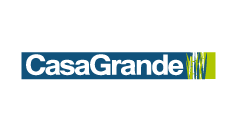ABOUT USMenu
We are the nation's largest sugarmill
Casa Grande SAA is an agribusiness dedicated to the cultivation and industrialization of sugar cane and its derivatives: sugar, alcohol, molasses and bagasse. It is located 610 km north of Lima, in the province of Ascope, Libertad region.
It is the country's largest sugarmill, with more than 30 thousand hectares. It became part of Grupo Gloria since January 29, 2006, beginning thereon a recovery path after a long decline period. Previously cultivated area totaled 11,000 hectares, the daily grind reached 4,000 tons on average and sugar production was 426 tons per day. Grupo Gloria has enabled Casa Grande to currently have more than 20 thousand hectares, its daily grind exceeds 9,000 and sugar production is around 1,000 tons per day.
Due to its great size, Casa Grande fields are controlled in three divisions: Rome with over 6,000 hectares, Farias with about 5,500, Casa Grande with 6,500 and a small annex Chicamitawith 2,000.
The sugar mill works with two sinks, a mill and a diffuser. It also has a distillery, with an alcohol production capacity of 18 million liters per year.
Its growth has been based on the modernization of both the factory and laboratories, assurance of water resources with investments in wells, modern irrigation systems, expansion of the agricultural frontier, cutting-edge equipment acquisition and training of human resources.
HISTORY Go up
The beginnings of a great dreamSpanish chroniclers of the conquest relate that Captain Martin Bazan Heredia was the first owner of the haciendas (estates) Casa Grande, Facalá and Mocollope. His heirs sold the land to German Luis Albrecht, who created Casa Grande Zuckerplantagen AG around 1860, a company that operated with a modern factory, and even issued its own currency for internal operations.
Burdened by a painful illness and because of the economic crisis unleashed by the war with Chile, Albrecht auctioned his company on August 1, 1888 and it was acquired by compatriot Juan Gildemeister, who died in 1895. The company became managed by Enrique Gildemeister, experienced businessman, who acquired other estates to expand their agricultural frontier.
In 1915 the sugar industry experienced unprecedented world market prices boom due to the impact of the First World War. Don Enrique bought Malabrigo port, where overseas port operations were conducted. In 1927 he acquired the estate Rome, consolidating its territorial and economic supremacy in the Chicama Valley. Casa Grande thus became one of the most important agro-industrial empires of Peru.
With the military government reform in the seventies, Casa Grande complex was taken over by their workers whom associated in cooperatives and agricultural societies of social interest, with strong government presence in the board and amongst shareholders.
Before being taken over by the military government the hacienda Casa Grande owned large tracts of land: 107,717 acres in the coast and 75,086 acres in the mountains.
March 13, 1996, after failed attempts to change the cooperative model, the government enacted the DL 802, Financial and Economic Sanitation Law for Sugar Agribusiness Firms. On July 2, 1996, Casa Grande abides by this law and decides to change its social model, becoming a corporation. In March 1998, the transformation is completed, becoming a publicly traded company, allowing the entry of new investors.
After reducing its size to 30,000 acres, less than half of them cultivated, having large debts -mainly labor-, and constant social conflicts, the company was acquired by Grupo Gloria in late January 2006.
PRODUCTS Go up
Azúcar, Alcohol, Melaza y Bagazo
- Sugar
- Brown sugar export
- Brown sugar
- CASA GRANDE BROWN SUGAR X 1 kg x 25 p/bag
- CASA GRANDE BROWN SUGAR X 2 kg bag
- CASA GRANDE BROWN SUGAR X 5 kg bag
- CASA GRANDE BROWN SUGAR X 50 kg sack
- CASA GRANDE BROWN SUGAR X 1 kg x 25 p/bag
- Alcohol
- Rectified ethyl alcohol of 96°
- Industrial ethyl alcohol 94°
- Molasses
- Bagasse
